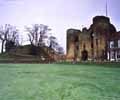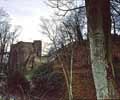Tonbridge
Kent
One could quite easily forgive the English, after their defeat at the Battle of Hastings in 1066, for associating the word Norman, for absolute control and possession. In fact, that is exactly what happened with the new order at Tonbridge, where the castle’s Norman commander and garrison controlled
traffic on the River Medway and its crossing.
Richard fitzGilbert built a motte and bailey castle here c.1069, after being granted this and other lands for his part in the conquest. He also became William the Conqueror’s Joint Chief Justiciar in his absence.
By 1088 Richard had joined with rebel leaders, Bishop Odo, Robert de Mortain and Robert de Bellême to unseat the Conqueror’s successor, his son King William II (Rufus) in favour of Robert II Duke of Normandy, William the Conquerer’s eldest son.
Rufus was quick off the mark in gathering his forces, and managing to enlist the English fyrd. After capturing Pevensey castle and two leading rebels, Bishop Odo and Robert de Mortain, Rufus flushed with success, marched into Kent and stormed Tonbridge castle on day two of the siege.
For punishment Rufus burned the castle and the town to the ground.
After Richard’s death in 1091, his son Gilbert fitzRichard inherited his father’s English property and it is about this time that the stone shell keep was built.
In 1215, during the baron’s rebellion against King John, Richard fitzGilbert’s grandson, Richard de Clare, attended the signing of the Magna Carta. Soon after, the King seized the castle but two years later, returned it.
The twin towered, stone gatehouse, which has withstood the centuries, was built by Richard de Clare, 6th Earl of Hertford and it is said to have taken 30 years to build. It has similarities to some of the Welsh castles and may have been designed by James of St George or Richard Lenginour. Both were in charge of King Edward I’s Welsh castle work. The connection, although tenuous, is made because King Edward once temporarily kept the great seal of England here during one of his visits to France. By 1314 the de Clares seem
not to be further involved with the castle.
During the Civil War it was garrisoned by Parliamentary forces and by 1646 the owner, Thomas Weller, was told to dismantle its defences.
It is now in the care of Tonbridge and Malling Borough Council and is open to the public.
English &Welsh Castle Picture Search Results
Your Search returned 3 pictures.
Click on a picture to enlarge and order


